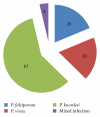Incidence of malaria in the interior division of sabah, malaysian borneo, based on nested PCR
- PMID: 22013506
- PMCID: PMC3195446
- DOI: 10.1155/2011/104284
Incidence of malaria in the interior division of sabah, malaysian borneo, based on nested PCR
Abstract
Introduction. Malaria is currently one of the most prevalent parasite-transmitted diseases caused by parasites of the genus Plasmodium. Misidentification of human malaria parasites especially P. knowlesi based on microscopic examination is very common. The objectives of this paper were to accurately identify the incidence of human malaria parasites in the interior division of Sabah, Malaysian Borneo, based on small subunit ribosomal RNA (ssrRNA) and to determine the misidentification rate in human malaria parasites. Methods. Nested PCR was used to detect the presence of human malaria parasites. A total of 243 blood spot samples from patients who had requested for blood film for malaria parasite (BFMP) analyses were used in this study. Results. Nested PCR findings showed that there was no P. malariae infection while the highest prevalent malaria parasite was P. knowlesi, followed by P. vivax, P. falciparum, and mixed infection. Only 69.5% of the 243 samples giving consistent nested PCR and microscopic results. Conclusion. The preliminary findings from molecular detection of malaria showed that P. knowlesi was the most prevalent Plasmodium species in the interior division of Sabah. The findings from this paper may provide a clearer picture on the actual transmission of different Plasmodium species in this region.
Figures




References
-
- WHO. World Health Organization; 2009. World malaria report 2009. Tech. Rep.
-
- Vythilingam I, Chan ST, Shanmugratnam C, Tanrang H, Chooi KH. The impact of development and malaria control activities on its vectors in the Kinabatangan area of Sabah, East Malaysia. Acta Tropica. 2005;96(1):24–30. - PubMed
-
- Singh B, Cox-Singh J. Parasites that cause problems in Malaysia: soil-transmitted helminths and malaria parasites. Trends in Parasitology. 2001;17(12):597–600. - PubMed
-
- White NJ. Plasmodium knowlesi: the fifth human malaria parasite. Clinical Infectious Diseases. 2008;46(2):172–173. - PubMed
LinkOut - more resources
Full Text Sources

